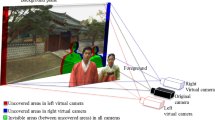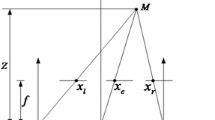Abstract
In this paper, we propose a novel freeview generation system. We first discuss the problem of misalignment of the edges between color frame and depth frame, and propose an optimization method to solve it. Then an original frame is separated into two parts, depending on the sizes of the resulting dis-occluded areas in the virtual view. Illumination changes between current frame and the information from previous frames are modeled and compensated. In the virtual view, the missing pixels are recovered by the proposed inpainting method. Using depth information, we compute the priority of the recovering order among the missing pixels. The recovering process accounts for pixel consistency, and the process iterates between virtual color frame and depth frame. Experimental results show that, compared with a state-of-the-art work, the proposed method has better subjective and objective performances; the PSNR gain can be up to 2.9575 dB.













Similar content being viewed by others
References
Bertalmio M, Sapiro G, Caselles V, Ballester C (2000) Image inpainting. In: SIGGRAPH '00 Proceedings of the 27th Annual Conference on Computer Graphics and Interactive Techniques, ACM Press/Addison-Wesley Publishing Co., New York, pp 417–424
Criminisi A, Pérez P, Toyama K (2004) Region filling and object removal by exemplar-based image inpainting. IEEE Trans Image Process 13:1200–1212
Dong T, Lai PL, Patrick L, Gomila C (2009) View synthesis techniques for 3D video. In: Proc. SPIE 7443, Applications of Digital Image Processing XXXII, 74430T. doi:10.1117/12.829372
Fehn C (2004) Depth-image-based rendering (DIBR), compression, and transmission for a new approach on 3D-TV. In: Proc. SPIE 5291, Stereoscopic Displays and Virtual Reality Systems XI, 93. doi:10.1117/12.524762
Hervieu A, Papadakis N, Bugeau A, Gargallo P, Caselles V (2010) Stereoscopic image inpainting: distinct depth maps and images inpainting. Pattern Recognition (ICPR), 2010 20th International Conference on, pp 4101–4104. doi:10.1109/ICPR.2010.997
Kauff P, Atzpadin N, Fehn C, Müller M, Smolic A, Tanger R (2007) Depth map creation and image-based rendering for advanced 3DTV services providing interoperability and scalability. Sig Process Image Commun Spec Issue Three-Dim VIdeo Telev 22:217–234
Ndjiki-Nya P, Koppel M, Doshkov D, Lakshman H, Merkle P, Muller K, Wiegand T (2011) Depth image based rendering with advanced texture synthesis for 3-D video. IEEE Trans Multimed 13:453–465
Schmeing M, Jiang X (2010) Depth Image Based Rendering: A faithful approach for the disocclusion problem, 3DTV-Conference: The True Vision - Capture, Transmission and Display of 3D Video (3DTV-CON), pp 1-4. doi:10.1109/3DTV.2010.5506596
Smolic A, Mueller K, Merkle P (2006) 3D video and free viewpoint video technologies, applications and MPEG standards. IEEE Int Conf Multimed Expo 53:2161–2164
Smolic A, Muller K, Dix K, Merkle P, Kauff P, Wiegand T (2008) Intermediate view interpolation based on multiview video plus depth for advanced 3D video systems. IEEE Int Conf Image Process 11:2448–2451
Solh M, AlRegib G (2012) Hierarchical Hole-Filling For Depth-Based View Synthesis in FTV and 3D Video. IEEE Journal of Selected Topics in Signal Processing 6(5):495–504
Wang L, Jin H, Yang R, Gong M (2008) Stereoscopic inpainting: joint color and depth completion from stereo images. IEEE Conf Comput Vis Pattern Recog 10:1–8
Zhang L, Tam W (2005) Stereoscopic image generation based on depth images for 3D TV. IEEE Trans Broadcast 51:191–199
Acknowledgments
This research is supported by the National Science Council, Taiwan, under Grants NSC 101-2221-E-033-036, NSC 102-2221-E-033-018, NSC-102-2221-E-033-063, by the Ministry of Science and Technology, Taiwan under Grant MOST 103-2221-E-033-020, MOST-103-2221-E-033-070, MOST-103-2622-E-033-001-CC2, and by the College of Electrical Engineering and Computer Science in Chung Yuan Christian University, Taiwan under Grant CYCU-EECS-10301.
Author information
Authors and Affiliations
Corresponding author
Rights and permissions
About this article
Cite this article
Lin, TL., Thakur, U.S., Chou, CC. et al. Hole filling using multiple frames and iterative texture synthesis with illumination compensation. Multimed Tools Appl 75, 1899–1921 (2016). https://doi.org/10.1007/s11042-014-2379-2
Received:
Revised:
Accepted:
Published:
Issue Date:
DOI: https://doi.org/10.1007/s11042-014-2379-2




